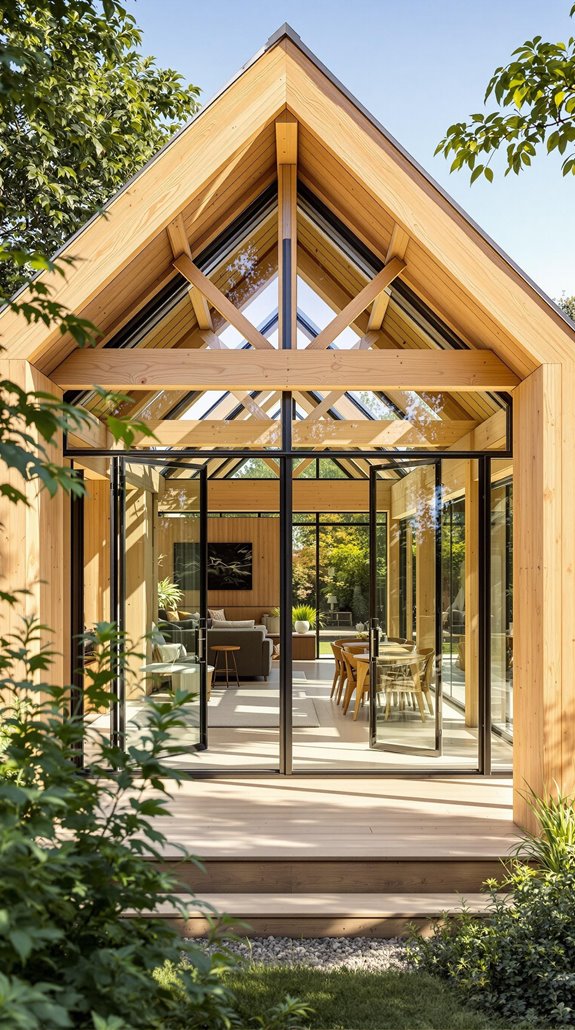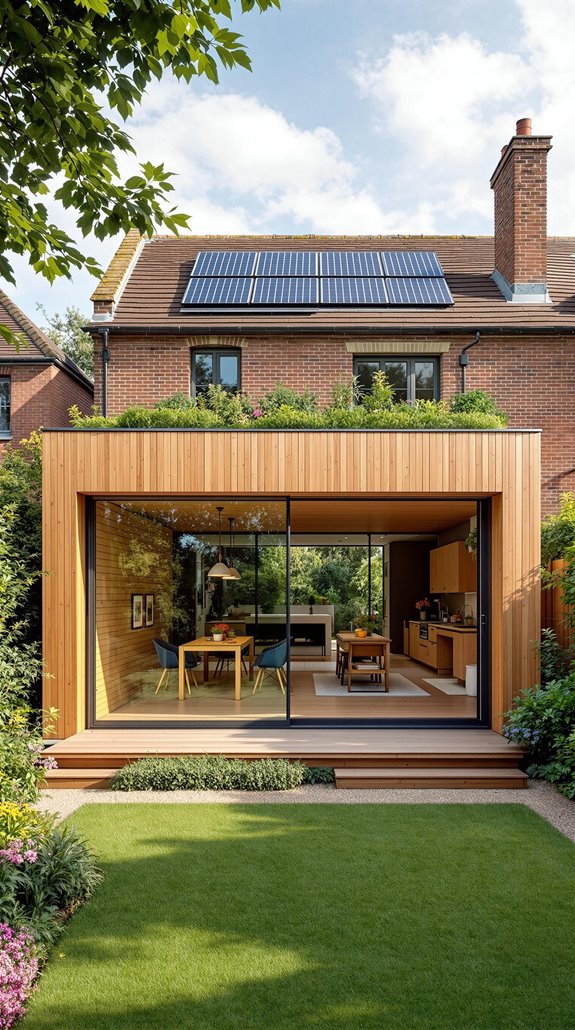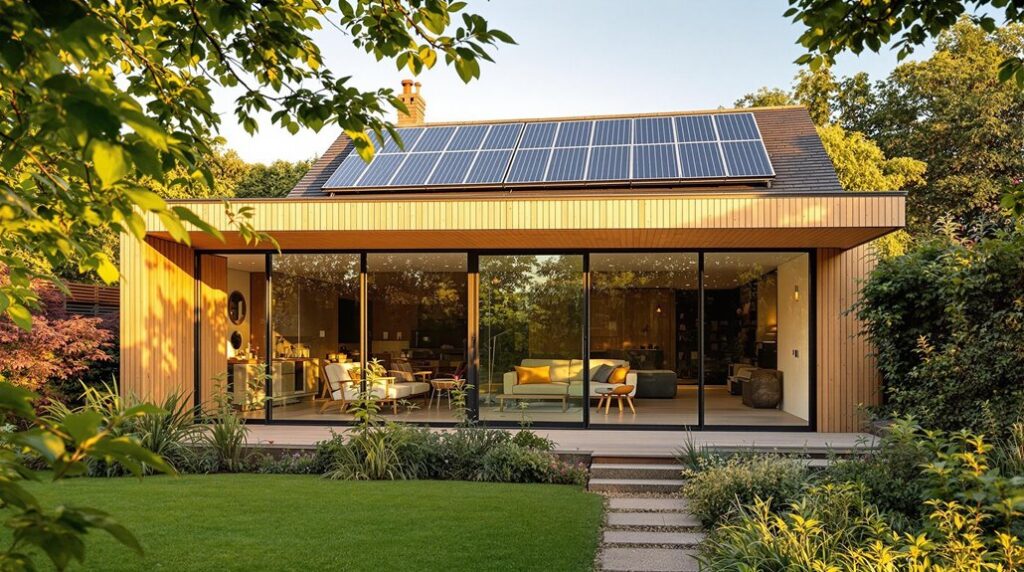I’ve been analyzing the timber extension market across the UK, and I’m convinced you’re looking at the most cost-effective sustainable building solution available today. The numbers don’t lie—timber frame construction delivers 30% better thermal performance than traditional brick while reducing your carbon footprint by up to 40%. What’s caught my attention isn’t just the environmental benefits, though. There’s a specific cost calculation that most homeowners completely overlook when budgeting for their extension.
Key Takeaways
- Timber frame extensions cost £1,600-£2,700 per m² and reduce carbon emissions by up to 40% while acting as natural carbon sinks.
- UK timber frame adoption increased from 9% to 16% between 2019-2023, supported by government roadmaps targeting net-zero goals by 2050.
- Offsite timber manufacturing reduces construction waste by 50% and energy consumption by 25% compared to traditional building methods.
- Timber enables unique eco-chic designs including L-shaped configurations, curved sections, cantilevered overhangs, and full-height glazed gables for maximum natural light.
- Digital Twin Technology and robotics in timber construction improve design accuracy, reduce errors, and boost production speed for premium sustainable extensions.
The Rising Popularity of Timber Frame Construction in the UK

While England has historically lagged behind Scotland in timber frame adoption, the construction industry’s landscape is rapidly shifting toward sustainable building methods. I’ve witnessed timber frame usage in English new builds jump from just 9% in 2019 to 16% in 2023, demonstrating clear momentum toward Scotland’s impressive 92% adoption rate.
You’ll find major UK housebuilders now incorporating timber frame facilities into their portfolios, recognizing the method’s superior thermal performance and alignment with tighter energy efficiency standards. The UK Government’s Timber in Construction Roadmap 2025 directly supports this shift, targeting increased timber use to achieve net-zero goals by 2050. Additionally, the rise of modular housing demonstrates the growing emphasis on innovative construction techniques that prioritize sustainability.
What’s driving this change? Offsite manufacturing reduces construction waste by 50% and energy consumption by 25%, while supporting the commitment to build 1.5 million sustainable homes by 2030. The introduction of the Future Homes Standard promotes timber construction specifically for its exceptional thermal and carbon performance benefits.
Cost Breakdown: What You’ll Pay for Your Timber Extension
Before diving into your timber extension project, you’ll need to understand the financial investment required. I’ll break down the costs you’re likely to encounter.
Standard timber frame extensions typically cost £1,600–£2,700 per m², with premium oak materials pushing prices to £2,200–£2,700 per m². For a 15m² extension, expect £24,000–£40,500, while a 30m² project runs £48,000–£81,000. Adding extra living space through a timber extension can significantly increase your home’s resale value, making it a worthwhile investment.
Material choice greatly impacts your budget. Pine timber offers the most affordable option at £1,600–£2,100 per m², while red oak reaches £2,200–£2,700 per m². However, lower-priced timbers may compromise structural support over time, making quality timber selection crucial for long-term durability.
Don’t forget additional expenses: groundwork adds £1,400–£2,400 per m², planning permissions cost 5–10% of total project value, and I recommend budgeting 10% contingency for unexpected costs.
Environmental Benefits That Make Timber the Smart Choice
As environmental consciousness drives modern construction decisions, timber emerges as the most sustainable choice for your home extension. I’ll show you why timber’s environmental credentials make it the smart selection for eco-conscious homeowners.
Timber acts as a carbon sink, storing CO2 throughout its lifespan while delivering up to 40% carbon reduction compared to conventional materials. You’ll benefit from wood’s natural insulating properties, which regulate temperatures and reduce energy consumption considerably. Additionally, a narrow side return extension can further enhance natural light within your new space, creating a bright and inviting atmosphere.
As a renewable resource, timber requires fewer materials and creates minimal waste through prefabrication methods. I recommend choosing FSC or PEFC certified timber to guarantee responsible sourcing from managed forests.
When your extension reaches end-of-life, timber’s fully recyclable nature supports circular economy principles, allowing materials to be repurposed rather than discarded. The superior insulation provided by timber frames creates long-term energy savings that can offset initial material costs while reducing your carbon emissions over time.
Design Possibilities and Architectural Flexibility
When planning your timber house extension, you’ll discover that wood’s inherent workability reveals design possibilities that conventional materials simply can’t match. I’ll show you how timber frame systems seamlessly integrate with your existing brick structure while creating striking kerb appeal that transforms your property’s character.
You can achieve non-standard geometric configurations through precision-cut engineered timber. L-shaped extensions optimize your plot usage, while curved designs create unique silhouettes. Cantilevered sections enable dramatic overhangs without external supports. The sustainable nature of timber construction also contributes to a lower carbon footprint, enhancing your home’s overall environmental impact.
Timber’s lightweight properties overcome restricted-access sites through phased assembly. You’ll maximize natural light with full-height glazed gables and corner glazing that eliminates visual barriers. Vaulted ceilings with exposed rafters enhance volume, while Glulam beams achieve column-free spans exceeding 10 meters for truly open-plan living. Permitted Development regulations can enable dormer loft conversions that maximize allowable addition volume for budget-conscious families.
Key Factors That Influence Your Extension Budget

Since timber extensions involve multiple cost variables that interact in complex ways, understanding these factors will help you establish a realistic budget from the outset. I’ll break down the key elements that’ll impact your project costs.
Size directly affects pricing, with costs ranging £1,400–£2,700 per square meter. A single-storey 4m x 5m extension averages £28,880, while two-storey versions cost 50% more. Your timber choice matters too—pine runs £1,600–£2,100 per m², while premium oak adds 20–30% due to superior durability. Additionally, selecting high-quality materials can enhance the longevity and aesthetics of your extension.
Location greatly influences expenses through regional labor variations and site preparation requirements. Groundwork and drainage add £1,400–£2,400 per m² beyond initial quotes. Design complexity significantly impacts your final investment, with simpler designs proving more cost-effective than elaborate custom configurations. Don’t overlook hidden costs like plastering, electrical work, and insulation upgrades, which typically add 10–15% to your budget.
Future Outlook for Timber Construction Technology
While traditional timber construction has relied heavily on manual processes and conventional design methods, the industry stands at the threshold of a technological revolution that’ll fundamentally transform how we approach timber extensions. Incorporating durable materials into your design will also enhance the longevity of your project.
I’m seeing AI-driven analytics and IoT sensors enabling real-time tracking throughout your project’s supply chain, while blockchain technology guarantees complete transparency in material sourcing. Digital twin technology lets you virtually prototype your extension before construction begins, eliminating costly errors.
By 2025, we’ll have new PAS standards specifically for timber-based Modern Methods of Construction, plus government-backed cost-comparison guides. Robotics in offsite factories will boost production speed and quality control for your prefabricated components. The government’s commitment to delivering 1.5 million homes during the current Parliament is driving significant investment in these advanced timber construction technologies.
These innovations position timber extensions as the smart choice for forward-thinking homeowners seeking sustainable, efficient solutions.
Conclusion
I’ve shown you timber extensions offer exceptional value through superior thermal performance, carbon sequestration benefits, and design versatility. You’ll find costs vary considerably based on complexity, materials, and local regulations. Consider your specific site constraints, planning requirements, and long-term energy savings when budgeting. Timber frame technology continues advancing with improved joinery systems and sustainable sourcing. You’re investing in proven construction methods that’ll deliver lasting performance while meeting stringent UK building standards.
References
- https://ukconstructionblog.co.uk/cost-of-timber-frame-extension/
- https://pocketmags.com/ca/build-it-magazine/january-2025/articles/1479800/the-rise-of-timber-frame-construction
- https://www.myjobquote.co.uk/costs/timber-frame-extension
- https://timberdevelopment.uk/a-timber-framed-future-for-uk-housing/
- https://www.gov.uk/government/publications/timber-in-construction-roadmap-2025/timber-in-construction-roadmap-2025
- https://www.ttjonline.com/analysis/uk-timber-industry-predictions-2025-looking-ahead/
- https://www.designingbuildings.co.uk/wiki/Timber in Construction Roadmap
- https://ofptimberframe.com/top-3-construction-trends-for-2025/
- https://timberdevelopment.uk/construction-statistics-show-output-falling-in-may/
- https://www.checkatrade.com/blog/cost-guides/timber-frame-extension-cost-per-m2/

